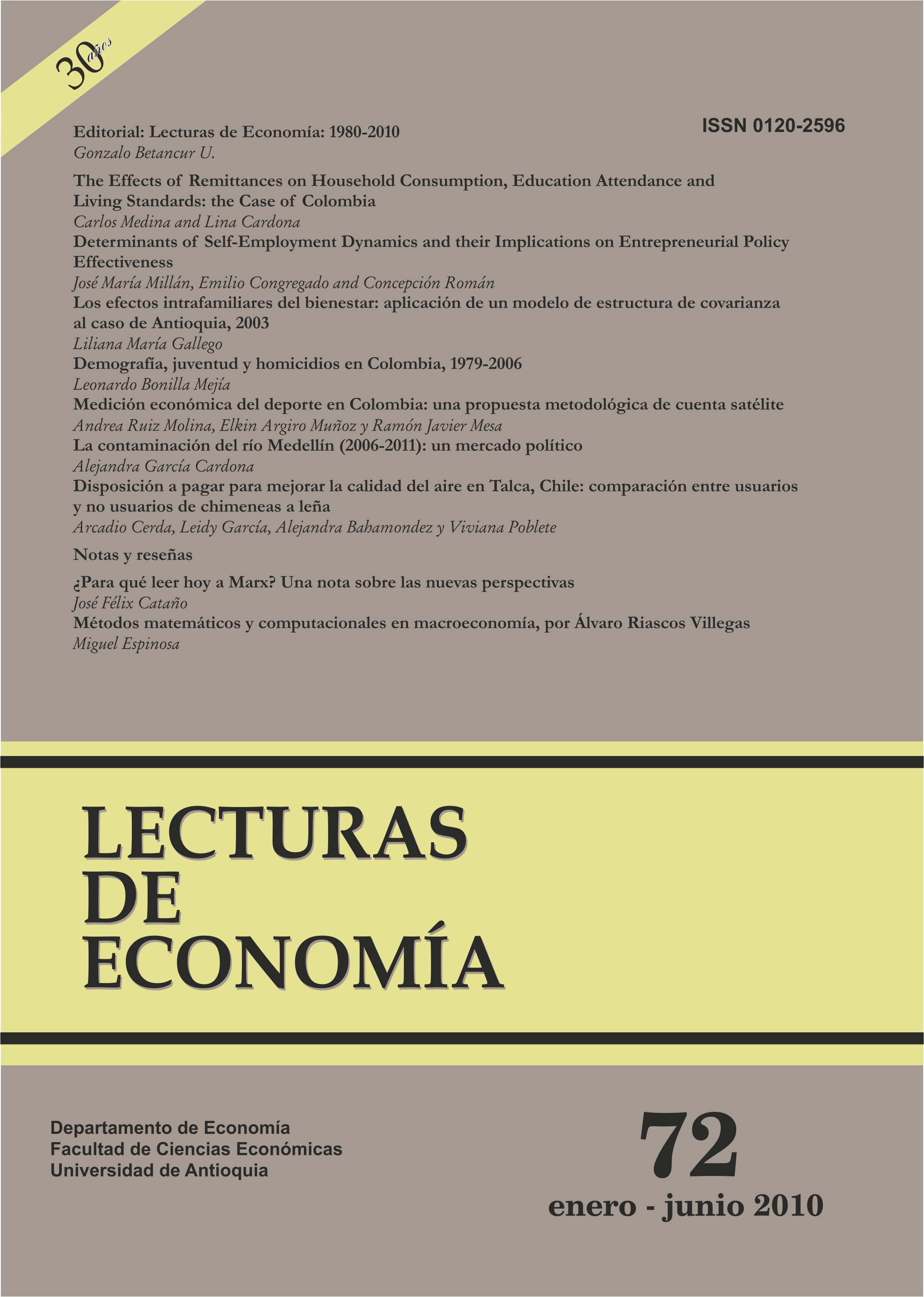A Covariance Structure Analysis of the Intrafamilial Effects of Well-Being: the Case of Antioquia (Colombia), 2003
DOI:
https://doi.org/10.17533/udea.le.n72a6500Keywords:
capability approach, children and young people, well being, Structural Equation Model (SEM)Abstract
This study suggests that children capabilities are influenced by family surroundings inducing household well-being in the functioning space of the household to influence health and education levels. The methodology applied in this study follows a Covariance Structure Model and analyzes the case of Antioquia (Colombia). The results suggest positive impacts of education and household well-being, affecting children’s education and health levels. This suggests that the State should encourage policies aimed at improving people’s well-being in order to increase freedom of opportunity.
Downloads
References
Addabbo, Tindara, et al. (2004). “To what extent fuzzy set theory and structural equation modelling can measure functionings? An application to child well being”, Materiali di Discussione del Dipartimento di Economia Politica, University of Modena and Reggio Emilia, No. 468, pp. 1-28.
Addabbo, Tindara, et al. (2008a). “The interaction between parents and children as a relevant dimension of child well being. The case of Italy”, Materiali di Discussione del Dipartimento di Economia Politica, University of Modena and Reggio Emilia, No. 585, pp. 1-21.
Addabbo, Tindara y Di Tommaso, Maria (2008b). “Children capabilities and family characteristics in Italy”, Materiali di discussion del Dipartimento di Economia Politica, University of Modena and Reggio Emilia, No. 590, pp. 1-37.
Alkire, Sabina (2002). Valuing Freedoms: Sen’s Capability Approach and Poverty Reduction, Oxford, Oxford University Press.
Bentler, Peter (1980). “Multivariate Analysis with Latent Variables: Causal Modeling”, Annual Review of Psychology, No. 31, pp. 419-456.
Bentler, Peter y Weeks, David (1980). “Linear Structural Equations with latent variables”, Psychometrika, No. 45, pp. 289-308.
Bielby, William y Hauser, Robert (1977). “Structural Equation Models”, Annual Review of Sociology, No. 3, pp.137-161.
Byrne, Barbara (2006). Structural Equation Modeling With EQS. Basic Concepts, Applications, and Programming, New Jersey, Lawrence Erlbaum Associates, Inc.
Di Tommaso, Maria (2007). “Children Capabilities: A structural equation model for India”, The Journal Socio-Economics, No. 36, pp. 436-450.
Goldberger, Arthur (1972). “Structural Equation Methods in the Social Sciences”, Econometrica, No. 40, pp. 979-1001.
Hair, Joseph, et al. (2005). Análisis Multivariante 5ª ed., Madrid, Prentice Hall Iberia.
Jöreskog, Karl (1973). “A General Method for Estimating a Linear Structural Equation System”, En: Structural Equation Models in the Social Sciences, Goldberger Arthur y Duncan, Otis, eds., New York, Seminar Press.
Jöreskog, Karl y Sörbom, Dag (1989). Lisrel 7: A guide to the Program Aplications, Chicago, SPSS Inc.
Krishnakumar, Jaya (2005). “Going Beyond Functionings to Capabilities: An Econometric Model to Explain and Estimate Capabilities”, Journal of Human Development and Capabilities, Vol. VIII, No.1, Marzo 2007, pp. 39-63.
Krishnakumar, Jaya y Ballon, Paola (2008). “Estimating Basic Capabilities: A Structural Equation Model Applied to Bolivia”, World Development, Vol. XXXVI, No. 6, pp. 992-1010.
Kuklys, Wiebke (2005). Amartya Sen’s Capability Approach: Theoretical Insights and Empirical Applications. Studies in Choice and Welfare, Berlin, Springer.
Long, Scott (1983). “Confirmatory Factor Analysis. A preface to LISREL”, Sage University Papers, Serie Quantitative Applications in the Social Sciences, No. 33, pp. 1-88.
López, Hugo y Núñez, Jairo (2007). Pobreza y desigualdad en Colombia. Diagnóstico y estrategias, Bogotá, Departamento Nacional de Planeación.
Nussbaum, Martha y Sen, Amartya (Ed) (1993). The Quality of Life, Oxford, Oxford University Press.
Nussbaum, Martha (2000). Women and Human Development: The Capabilities Approach, New York, Cambridge University Press.
Gobernación de Antioquia (2008). Anuario Estadístico de Antioquia: 2008, Medellín, Departamento Administrativo de Planeación.
Gobernación de Antioquia (2008). Plan de Desarrollo de Antioquia “Antioquia para todos, manos a la obra: 2008-2011”, Medellín, Gabinete Departamental.
Ruggeri, Caterina (2001). Do Concepts Matter? An Empirical Investigation of the Differences Between a Capability and a Monetary Assessment of Poverty, Oxford, University of Oxford.
SAS/STAT (2003). User’s Guide, Version 9.1.3, Cary, SAS Institute Inc.
Sen, Amartya (1981). Poverty and Famines: An Essay on Entitlement and Deprivation, Oxford, Clarendon Press.
Sen, Amartya (1985). Commodities and Capabilities, Amsterdam, NorthHolland.
Sen, Amartya (1997). Bienestar Justicia y Mercado, Barcelona, Paidós I.C.E./ UAB.
Sen, Amartya (1999). Development as Freedom, Oxford, Oxford University Press.
Uriel, Ezequiel y Aldás, Joaquín (2005). Análisis Multivariable Aplicado, Madrid, International Thomson Editores Spain.
Visauta, Bienvenido (1986). Modelos Causales, Técnicas de Investigación Social, Barcelona, Editorial Hispano Europea, S.A.
Wagle, Udaya (2005). “Multidimensional poverty measurement with economic well-being, poverty and social inclusion: a case from Kathmandu, Nepal”, Journal of Human Development, Vol. 6, No. 3, pp. 301-328.
Published
How to Cite
Issue
Section
License
This page, by Universidad de Antioquia, is licensed under a Creative Commons Attribution License.
Authors who publish with this journal agree to retain copyright and grant the journal right of first publication, with the article licensed under a Creative Commons Attribution-NonCommercial-ShareAlike License allowing others to share it as long as they acknowledge its authorship and original publication in this journal.
Authors can enter into separate, additional contractual arrangements for the non-exclusive distribution of the journal's published version of the work (e.g., post it to an institutional repository or publish it in a book), provided that these arrangements be not for profit and the journal be acknowledged as the original source of publication.
Authors are permitted and encouraged to post their papers online (e.g., in institutional repositories or on their websites), as it can lead to valuable exchanges as well as greater citation of the published work.







